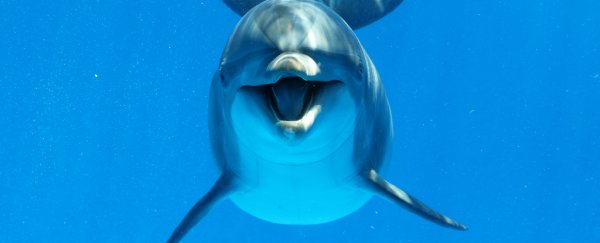The vast majority of humans are right-handed, something that's hard-wired into the architecture of our brain. When it comes to animals, their 'sidedness' tends to vary a bit more - now, we have evidence that in dolphins, lefties are a minority, too.
Researchers working with the Dolphin Communication Project in the US spent six years watching a population of common bottlenose dolphins (Tursiops truncatus) forage from the ocean floor, taking note of which way they tended to turn, and found the animals like to keep their right eye on the food.
Having a preference for one side of the body or the other is now understood to be common throughout the animal kingdom. Gorillas and chimpanzees favour their right hands, like us. But in most orangutans, as well as animals such as kangaroos and cockatoos, the paw or claw on the left is usually the dominant.
Giraffes usually put out their left leg before their right when sinking down for a drink, and reindeer herds tend to move in a counter-clockwise direction. In fact, from lions to bats to chickens or even bees, it's looking like a lot of different animals have some sort of lateral bias.
Such a bias makes sense when we consider that nervous systems usually consist of a left and right hemisphere. Not only does each half of the brain hold jurisdiction over the opposite half of the body, the left and right hemispheres also dominate in respective tasks in what is referred to as lateralisation.
For example, in humans, visual processing of spaces occurs mostly in the right hemisphere, while for 95 percent of people language processing is primarily a talent of the left. Curiously, among left-handed people, this figure is closer to 70 percent.
When it comes to the lateralisation of common bottlenose dolphin brains, there have been clues in how their close relatives move.
Indo-Pacific bottlenose dolphins (T. aduncus) like to keep their left eye on things while rubbing fins with friends, for example. Baby belugas (Delphinapterus leucas) also prefer to keep mum in their left field of vision.
But just as humans and orangutans have different hand preferences, belonging to the same branch of the family tree is no guarantee of possessing the same biases.
Striped dolphins (Stenella coeruleoalba), for instance, check out unfamiliar objects with their right eye. Dusky dolphins (Lagenorhynchus obscurus) keep their right side towards prey as they circle them in a hunt.
To work out which way the dolphins of the common bottlenose variety lean while finding food, the researchers recorded the sounds and movements of just under 30 individuals off Bimini in The Bahamas.
Specifically, they noted which way the animals turned while practising what's known as crater feeding – a nose-down method of foraging that involves scanning the sand for prey and buzzing the floor with their echolocation.
In a tally of 709 pinwheel spins performed by several dozen dolphins, 705 steered left, using their right eye to look for a meal.
This suggests to the researchers that the left hemisphere of their brains does most of the processing prey-related sensory information, either of a visual nature or also involving echolocation.
Interestingly, the four 'left eyed' manoeuvres were all carried out by just one individual. While the statistics aren't exactly overwhelming, it could point to an atypical 'south paw' dolphin whose brain is lateralised differently to the others.
How different species specialise regions of their brains could tell us how our respective nervous systems evolved over time, localising tasks to maximise efficiency.
There are also potential domino effects from other body parts that could encourage one side of the brain to develop a specific skill more than the other.
In the case of dolphins, for example, it's possible that an asymmetry in the skull could have evolved with changes in the position of their larynx as their food channel widened to accommodate bigger prey.
There are still plenty of unanswered questions, not to mention a bunch of myths when it comes to our own tendency to favour one hand over the other.
"Advances in non-invasive brain imaging techniques hold the potential to further explore the link between behavioural laterality and hemispheric specialisation and sensory and cognitive processing," the researchers conclude in their report.
This research was published in Royal Society Open Science.
